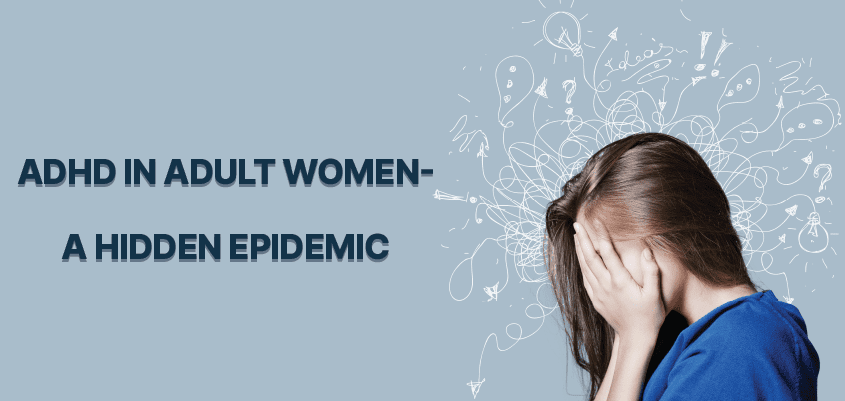Introduction
ADHD [Attention Deficit Hyperactivity Disorder] research has often focused on children and men more than women [1]. This has led to women getting a diagnosis either later in life or with less prevalence or misdiagnosis, often making it a “hidden” issue in women’s lives. This article explores what ADHD in adult women looks like.
Signs and Symptoms of ADHD In Adult Women
ADHD is characterized by hyperactivity, impulsivity, and inattention. While the presentation of symptoms differs in different individuals, it is often ignored or misdiagnosed in women because the symptoms’ appearance differs from what appears in men [2]. Common signs and symptoms for women are as follows [1] [2] [3] [4]:
- Feeling disorganized, chaotic, or out of control in daily life, along with poor planning and structuring skills
- Struggling with indecisiveness
- Dysregulation of attention, emotions, and behavior
- Difficulty managing work, family, and children, facing financial problems
- Difficulty handling time and procrastination
- Tendency to get bored quickly and avoid mundane tasks
- Struggling with low motivation
- Having poor social relationships and social behavior, along with difficulty in social interactions
- Psychological conditions like depression, anxiety, chronic stress, and suicidal ideation can be due to ADHD.
- Low self-esteem and a high tendency to self-blame
- Insomnia
- Chronic Pain
- Risky sexual behavior
In men, the symptoms are more disruptive and aggressive, because of which recognition is easy. On the other hand, in women, the above are misdiagnosed as mood or personality disorders [2]. It may go undiagnosed till one of their children receives a diagnosis, or their problems with attention, organization, initiation, and going back to a task after interruption increases after the birth of their children [4].
What are The Causes of ADHD In Adult Women?
ADHD is present in children from birth, and it is a neurodevelopmental disorder. While the degree to which it will be visible or impact a child is different for all, it affects all aspects of a person’s life.
There has been extensive research in determining the cause of ADHD, but the current consensus is that there is no singular or straightforward cause of ADHD [3]. Further, the risk factors in men and women are similar and include the following:

- Genetic Influences: Many researchers have found that ADHD has a vital genetic component [4], with some studies suggesting that the heritability of this disorder is 60-90% [5]. Family members with other neurodevelopmental disorders, such as Autism, have also been linked as a risk factor [6].
- Environmental Factors: exposure of the fetus to harmful environments during pregnancy, such as alcohol or drugs, maternal hypertension, conditions like low birth weight, and pre-term birth are also considered risk factors [2] [6]. Some studies have indicated that conflicts or adversity in early childhood and the mother’s pathology also pose a risk of ADHD [7].
- Neural networks and function: individuals with ADHD have different neural networks, which affect how their attention, emotional regulation, and self-regulation work [2] [8].
Women are often diagnosed later in life, but that does not mean that ADHD begins in adulthood. Late diagnosis indicates that women had lived with this disorder their entire lives but did not get adequate treatment.
How is ADHD In Adult Women Different From Men?
Attention-deficit hyperactivity disorder (ADHD) manifests differently for women than for men. In men, it is easier to recognize the symptoms, and they often get assessment and treatment much earlier than women. Commonly these differences include experiencing different subtypes of symptoms, higher chances of anxiety or depression, different social expectations, and different coping mechanisms.
|
ADHD affects Men and Women Differently [2] [3] [4] |
|
| Women | Men |
| Inattention more common | Hyperactivity and Impulsivity are more common |
| Symptoms include disorganization, feeling lost, talking too much, emotional reactivity, flight of thoughts, daydreaming, etc. | Symptoms begin as disruption in the classroom, inability to sit, constant running around, aggression, frequent fights, disrespectful behavior, etc. |
| Risky sexual behavior, poor relationships, poor performance in academics, and low self-esteem, along with anxiety and depression, | Substance abuse, conduct disorder, disruption, and dangerous driving |
| Tendency to develop better coping or masking strategies by working harder (often due to harsh judgment and control by a society of disruptive behaviors) | Coping strategies are not as substantial |
Differences in the Manifestation of ADHD Symptoms
In women, symptoms of inattention are more common. This means women will appear forgetful, daydreaming, and disorganized [4]. Since this is often attributed to anxiety or depression, the need for assessment is not recognized [2].
Further, the manifestation of hyperactivity and impulsivity is also different in women [4]. Hyperactivity can include internal restlessness, flight of thoughts, hyper-talkativeness, and emotional reactivity.
Conversely, impulsivity can look like interrupting others, saying without thinking, suddenly changing directions in life, and acting out on impulses. Finally, when aggression is present, it is more covert and relational than overt or physical in men [3].
Thus, compared to more disruptive and aggressive behavior in men, symptoms in women are difficult to identify and are not attributed to ADHD.
Internalizing Symptoms: Anxiety and Depression
When women do go for assessment or treatment, the above symptoms are attributed to internalizing pathologies like depression or anxiety, or personality disorder [2]. Further, in women, ADHD is often accompanied by problems of anxiety and depression which further complicates the situation. Comorbid OCD and perfectionist tendencies are also expected, which hides the presence of ADHD [3].
Societal Expectations Lead to Hiding of ADHD
Society predicts different behaviors between men and women. With more “feminine” qualities of being friendly, obedient, and good with relations being expected, all the disruptive displays of ADHD are judged harshly. Numerous girls with ADHD try to conceal their issues and expend considerable effort [4]. To mitigate ADHD and lack of help in the presence of solid social sanctions, women tend to develop better-coping strategies and hide their symptoms [3]. Nonetheless, this can cause overwhelm, distress, and delay diagnosis. It also makes women more prone to lower self-concepts and high levels of psychological distress [4].
Other Aspects of ADHD in Women
Women tend to deal with ADHD more isolatedly than men. While men rely on family support and spousal help, women do not get such support [2]. Further, due to the hiding and hiddenness of ADHD, women are at risk of other issues, such as physical neglect and sexual abuse in childhood [9].
Finally, the effect of hormones like estrogen on the expression and treatment of ADHD is recently being focused on. Many studies miss this linkage and produce inconclusive results [10], but women often experience these unique effects that need to be understood in more depth.
How to Treat ADHD In Adult Women?
Since ADHD remains hidden in women, few individuals have developed specific intervention plans. Nonetheless, medication, lifestyle changes, and psychotherapy are the best treatments for women with ADHD [1].

- Treatment with medicines like stimulants can help increase focus and reduce symptoms of ADHD. In cases where stimulants do not work, non-stimulants are provided. In some cases, antidepressants may also be prescribed [1] [2] [11]
- Treatment with Psychotherapy: for women, therapy like Cognitive Behavioral Therapy that helps them understand their beliefs and effects of ADHD can help with self-esteem, anxiety, and depression. For young girls, social skills training can also help [12].
- Lifestyle changes, skills training, and support: many symptoms of ADHD can be managed by learning new skills around the organization and developing a supportive lifestyle. Women can also join support groups that help them manage day-to-day stressors [1].
Women diagnosed with ADHD can work with psychologists and psychiatrists to develop a plan of action that is suitable for them and helps them in managing their ADHD as well as the distress associated with it.
Read this article to get more information about-What is ADHD
Conclusion
ADHD in women is a common condition but often remains hidden due to how it manifests itself. Society’s expectations and demands, along with the misattribution of symptoms to depression or anxiety, usually mean that women are diagnosed later in life and receive less help. Nonetheless, the effects of ADHD on women and their lives are severe. Once diagnosed, women can work with professionals and receive adequate treatment to manage their symptoms. If you are a woman diagnosed with ADHD, you can get help from United We Care Platform. At United We Care, our team of wellness and mental health experts can guide you with the best methods for well-being.
References
- “ADHD in women,” WebMD. [Online]. Available here: .[Accessed: 14-Apr-2023]
- S. Fraticelli, G. Caratelli, D. D. Berardis, G. Ducci, M. Pettorruso, G. Martinotti, G. D. Cesare, and M. di Giannantonio, “Gender differences in attention deficit hyperactivity disorder: An update of the current evidence,” Rivista di Psichiatria, 01-Jul-2022. [Online]. Available here: . [Accessed: 14-Apr-2023].
- P. O. Quinn and M. Madhoo, “A review of attention-deficit/hyperactivity disorder in women and girls: Uncovering this hidden diagnosis,” Psychiatrist.com, 18-Mar-2022. [Online]. Available here: [Accessed: 14-Apr-2023].
- M. E. Holthe and E. Langvik, “The strives, struggles, and successes of women diagnosed with ADHD as adults,” SAGE Open, vol. 7, no. 1, p. 215824401770179, 2017.
- T.-J. Chen, C.-Y. Ji, S.-S. Wang, P. Lichtenstein, H. Larsson, and Z. Chang, “Genetic and environmental influences on the relationship between ADHD symptoms and internalizing problems: A Chinese twin study,” American Journal of Medical Genetics Part B: Neuropsychiatric Genetics, vol. 171, no. 7, pp. 931–937, 2015.
- A. Thapar, M. Cooper, O. Eyre, and K. Langley, “Practitioner review: What have we learned about the causes of ADHD?,” Journal of Child Psychology and Psychiatry, vol. 54, no. 1, pp. 3–16, 2012.
- J. Biederman, S. V. Faraone, and M. C. Monuteaux, “Differential effect of environmental adversity by gender: Rutter’s index of trouble in a group of boys and girls with and without ADHD,” American Journal of Psychiatry, vol. 159, no. 9, pp. 1556–1562, 2002.
- L. A. Hulvershorn, M. Mennes, F. X. Castellanos, A. Di Martino, M. P. Milham, T. A. Hummer, and A. K. Roy, “Abnormal amygdala functional connectivity associated with emotional lability in children with attention-deficit/hyperactivity disorder,” Journal of the American Academy of Child & Adolescent Psychiatry, vol. 53, no. 3, 2014.
- J. J. Rucklidge, D. L. Brown, S. Crawford, and B. J. Kaplan, “Retrospective reports of childhood trauma in adults with ADHD,” Journal of Attention Disorders, vol. 9, no. 4, pp. 631–641, 2006.
- R. Haimov-Kochman and I. Berger, “Cognitive functions of regularly cycling women may differ throughout the month, depending on sex hormone status; a possible explanation to conflicting results of studies of ADHD in females,” Frontiers in Human Neuroscience, vol. 8, 2014.
- “ADHD in women: Symptoms, diagnosis & treatment,” Cleveland Clinic. [Online]. Available here: [Accessed: 14-Apr-2023].
- “Treatment for ADHD in women and girls,” CHADD, 25-Mar-2022. [Online]. Available here: [Accessed: 14-Apr-2023].





